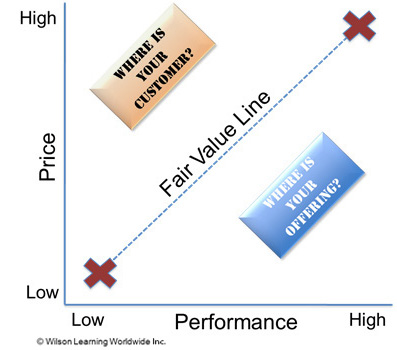Sales Differentiation Through Enhancing the Value

A recent conversation with a VP of Sales highlighted the frustrations of many sales professionals in this weak economy. "How do we gain the attention of customers when they are being flooded with calls from so many sales reps?" he asked. "How do we differentiate ourselves enough that they want to talk to us and not feel they are getting the same story they hear from every other company?"
These are good questions in a market where customers have smaller budgets and less time available to talk with suppliers. More companies are turning to RFPs as a way to limit the number of vendors they consider. Differentiating both the offering and the approach to the customer relationship has always been a competitive advantage. Today it is a critical necessity.
"SELLING VALUE"—KEY TO DIFFERENTIATION
The key, as always, is offering value—a term that has almost lost its meaning through overuse. Salespeople are often exhorted to "sell the value," without much direction as to what that means. Too often it means trying to convince the customer of what the salesperson believes is the value, and the presumed value is being used to justify a higher price.
But, if the focus shifts from the seller's point of view to the customer's, value means something very different. A customer's definition of value includes both price and performance. Sellers of higher-end products and services focus on high performance as value. Customers, on the other hand, regard price as a key element in their perception of value. They may or may not be looking for the highest level of performance, and may not be willing to pay a premium price to get it.
It's important to understand value as defined by each customer. The only definition of value that matters is the one from the customer's perspective. To effectively differentiate, salespeople need to consider two critical questions:
- Where is my customer located on the Value Map?
- What are the critical characteristics of performance for this customer?
WHERE IS MY CUSTOMER LOCATED?

If sellers of higher-end products and services focus on their own definition of value, they will miss a customer's preference. For example, not every business customer is willing to pay a premium for a level of performance they don't need. The place on the Value Map where customers are comfortable is where their required level of performance intersects with the right price.
To differentiate themselves from competitors, salespeople need to align with the customer's location on the Value Map, adjusting the performance level of the offering to be compatible with the customer's price requirements. This level of analysis makes it possible to offer the customer a solution that is different from what competitors are doing—falling back on familiar strategies of value-adds the customer may not want, or justifying the high price, again basing it on the seller's definition of value.
For customers who are seeking medium or even lesser performance, this might mean unbundling or looking for alternative approaches and less costly components for a solution. In cases where the customer is looking for higher performance and is willing to pay for it, the strategy would be to enhance the offering with features the customer wants and needs, while continuing, as always, to keep the price as compatible as possible with the customer's criteria for value. Some customers may indeed need and require the latest technology, the highest level of quality possible, or the fastest possible speed for their equipment or software. Others, however, are going to be satisfied with lesser performance in exchange for a lower price. What the customer is looking for in performance should be identified and clearly spelled out in the proposal.
WHAT ARE THE CRITICAL CHARACTERISTICS OF PERFORMANCE FOR MY CUSTOMER?
The key to matching the customer's definition of value requires a clear understanding of how they define performance. Typically, salespeople—and customers—tend to think of performance as pertaining to the solution or the features and benefits of the product. In fact, there is a much broader realm containing other aspects of performance that affect every phase of the customer's experience with the solution, from acquiring it to the time when it is renewed, replaced, or discarded. By understanding the customer's business and the activities, problems, and needs at each stage of the Customer Life Cycle, the salesperson can create additional, unique value that is difficult for competitors to match.
The Customer Life Cycle represents the customer's complete experience with a solution and consists of four phases, each of which offers opportunities for finding sources of value and differentiation.
- Shop—identifying the right solution, establishing criteria, and making a decision
- Buy—the process of contracting, financing, paying for, and receiving the service
- Use—implementing, installing, and using the solution
- Dispose—upgrading, extending, or ending use
In each of these areas, there are opportunities to solve a problem, create efficiencies, save the customer time, or reduce redundancies in their systems. The value to the customer can have a significant impact without necessarily adding cost. An example of adding value might be in the Shop phase, where a seller could consult with a potential customer to help define buying criteria, working with the people responsible for identifying solution requirements. Service providers can also ensure that services are easy to understand and that customers have tools and expert help in comparing technology and matching potential solutions with their requirements.
The Buy phase offers opportunities for assisting customers with the contracting process, or providing financing or leasing options. Helping with Buy issues can add value for the customer without adding to the cost of the sale or the cost of the solution. Other kinds of assistance might include accommodations on invoicing arrangements, or offering pre-payment or retainer agreements and timing to match the customer's budgeting cycle.
The Use phase is where most companies offer service to the customer. The customer expects that training and installation help will be provided. To add value above and beyond this expected offering, the salesperson needs an in-depth understanding of the customer's business. With this kind of understanding, a salesperson may be able to generate creative ideas for benefits unique to the customer's business. One sales rep observed how his company's technology was being used in his customer's warehouse operation and made suggestions that helped the customer achieve greater efficiency and accuracy in their picking and packing processes.
While often overlooked, there are many opportunities to provide new value at the Dispose phase as well. This could involve helping the customer measure results at the end of a contract, report on value achieved, or otherwise determine ROI. Salespeople may also conduct a new needs analysis to help customers determine whether there are additional needs for expanded services or updated technology.
Keep in mind that it is important, when enhancing value, to do it in a way that does not add significant cost for either the seller or the customer. Adding features that also add costs only moves higher on the Fair Value Line. Similarly, lowering costs by eliminating important features only moves down the Fair Value Line. To truly enhance value, the salesperson needs to find ways to enhance the overall performance of the product or service with few or no additional costs.
CONCLUSION: ENHANCING THE VALUE BEYOND EXPECTATIONS
What is needed to create differentiation is a reassessment of the concept of value and a better model for aligning with the customer's idea of fair value. By knowing where the customer is located on the Value Map, and understanding their criteria for fair price for the performance they require, the salesperson can offer a solution that precisely meets expectations. Such an offer will differentiate the offering from that of competitors.
By extending the value beyond customers' expectations, the salesperson can open up a still wider gap with the competition. The sales organization can enhance the customer's perception of value by adding to the performance in ways the customer may not have thought of. This can be achieved by leveraging the salesperson's knowledge of the customer's business to find sources of value across the entire Customer Life Cycle. Finding opportunities for low- or no-cost additions to performance enables the salesforce to offer value unique to their company and the customer—value that is difficult for competitors to match.
To learn more, contact Wilson Learning at 1.800.328.7937 or complete the online form.







 Please complete this form to download Sales Differentiation Through Enhancing the Value.
Please complete this form to download Sales Differentiation Through Enhancing the Value.



